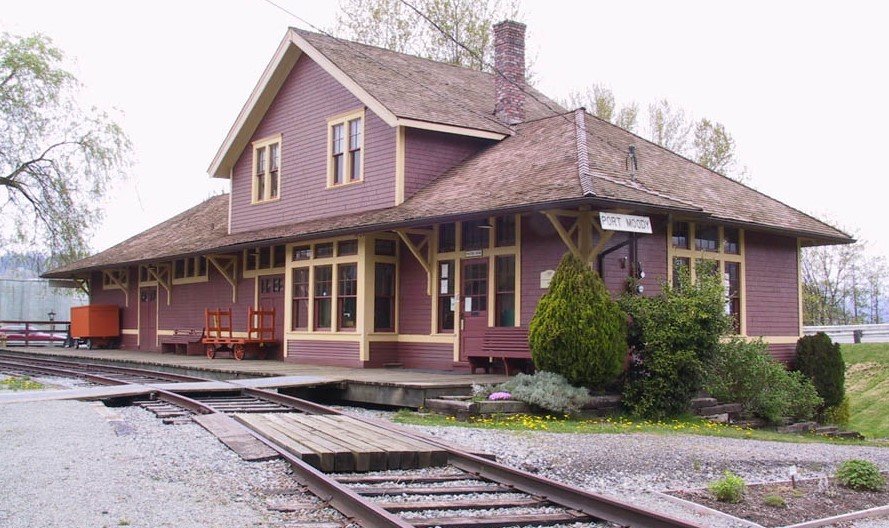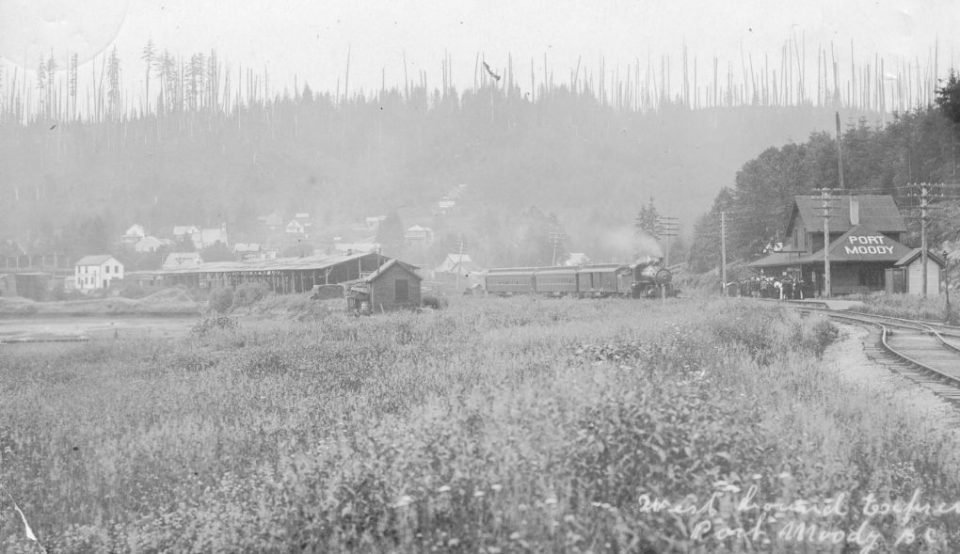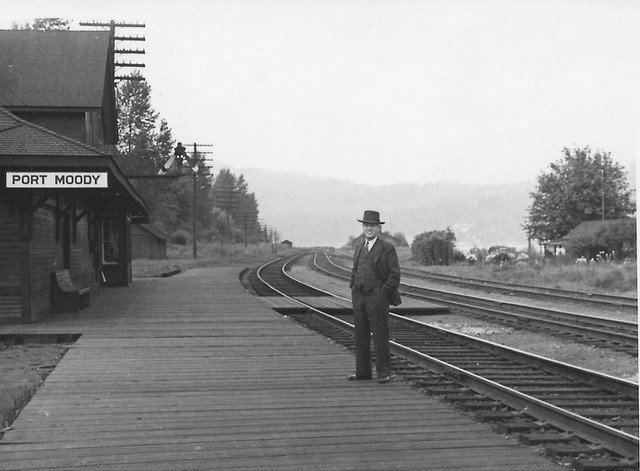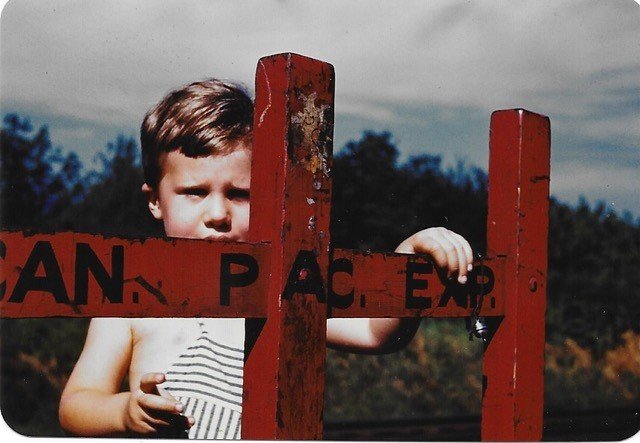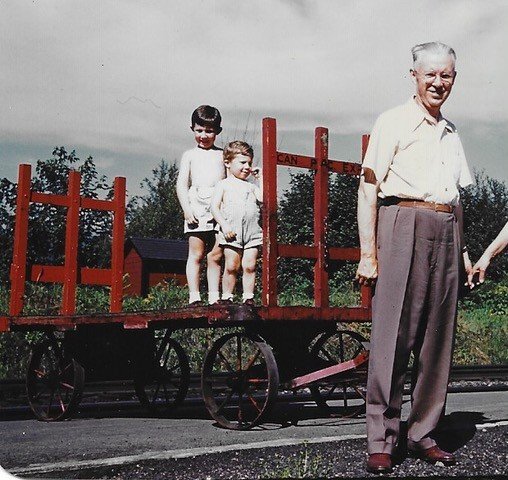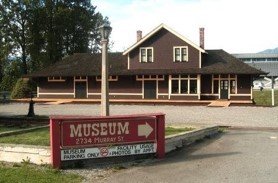Moving Port Moody Station
By Kyle Miller & Charles Reif
On the picturesque shore at the end of the Burrard inlet lies the Port Moody station, the committed terminus of the Canadian Pacific Railway at the first navigable tide waters of the Pacific Ocean.
But all is not as it seems. The station today is not the original one, nor is its’ location. The history of the Canadian Pacific Railway quest to unite the country with steel rails is an interesting one, and so is the story of Port Moody station.
Port Moody station sits in a beautiful location on the scenic Burrard inlet, Part of Rocky Point park and just a few steps from where it might once have served many travellers, businessmen, settlers and pioneers. But it wasn’t always here. In fact, this is its third location. How it got here is a tribute to the capabilities and ingenuity of the railroad it served.
Construction of the Port Moody Station began in 1907 and was finished in 1908. It is the second railway station built in the area. The station is an example of the standardized station designs developed by the Canadian Pacific Railway (CPR) during the Edwardian era to facilitate their expansion into western Canada. Built according to the Company’s standard station plan #9, it is typical of railway stations that dotted the country in the heyday of the railroads. This live-in station was home to the station master and his family.
In the Beginning
Port Moody Station was the End of the Line
When the Yellow Head Pass was officially adopted in 1873 as the route through the Rockies, various other routes had their advocates, including Howse Pass a bit north of the Kicking Horse Pass. No decision had yet been made on where the railway would reach the Pacific Ocean, and there was intense lobbying by Victoria and the Province of BC for a route from Yellow Head across the Chilcotin Plateau, down the Homathco River to Bute Inlet, across Seymour Narrows by bridge, and down Vancouver Island to Victoria. The Federal Government however favoured a mainland location. Two Governors-General attempted to mediate.
Sandford Fleming, who had taken over as engineer-in-chief in 1871 and managed far-flung survey crews looking for routes through the mountains, had still not committed fully to either the best pass through the Rockies or the Coast terminus by 1877. However, when he had finally solicited the views of the Admiralty the previous year about the best harbour along the coast, Burrard Inlet was their near-unanimous choice. Only in July 1878 did the Government of Canada settle officially on the Fraser River-Burrard Inlet route. The route through the Rockies was still undecided.
The history of the original Port Moody Station began when Canadian Pacific announced the official terminus of the line in 1879. Construction of the first station was completed in 1882, along the south shore of the Burrard Inlet, with dockage and a substantial wharf for receiving ships full of supplies and freight needed to build the track eastward. (Where Pacific Coast Terminals is now). It was demolished in 1961.
The original Port Moody Station, built in 1882 near the CPR wharf. Photo circa 1907.
First CPR Port Moody station, with British Man-of-war HMS Triumph anchored offshore in Burrard Inlet, Summer 1886.
The following few years were a period of great growth and excitement, as businesses and industry flourished. After 4 years of construction eastward, the Last Spike of the Canadian Pacific Railway was driven at Craigellachie, BC in November of 1885. The actual ‘first train’ to arrive in Port Moody was a work train that arrived from the East the day after the Last Spike, with little fanfair and no photographs. The link to the Pacific Ocean was complete.
CPR Engine 371 would bring the first scheduled cross Canada passenger train to arrive on July 4, 1886.
The prestige enjoyed by Port Moody would be short lived however, as the debate about the CPR’s commitment to the terminus at Port Moody for the long term grew. The railway had purchased two large parcels of land from the BC Government, one at English Bay and the other at Coal Harbour. In 1884, the CPR announced Vancouver as the new terminus. Locomotive 374 would be the proud leader of the first transcontinental passenger train to arrive in Vancouver, on May 23, 1887.
The impact of the relocated terminus affected Port Moody greatly, with many businesses leaving or trying to sell, and the population shrunk. Other opportunities for industry remained however, and a spur track to the imminent Imperial Oil Company (IOCO) refinery on the North Shore was completed in 1912. But most importantly, the CPR committed to build a new station in Port Moody. The station as we see it today is that second station, and it opened in 1908.
Why is that station moving down the tracks ?
Station Agent Tom Bundy stands on the passenger platform of the second station, at it’s original location along the Burrard Inlet.
Adolf and Okan Hungry Wolf, in their 1985 book “Canadian Railway Stories”, asked that question. They recounted how the second Port Moody station, built in 1908, had to move in early 1945, by CPR command.
CPR decided to move the station from its original location, at the western edge of Port Moody along the shore of the Burrard Inlet, to the bottom of Queen Street. The new location was closer to business and industry. This was certainly more convenient for the trains, the people, and the freight that they would carry.
As the Hungry Wolfs report, “In seven hours, with four to spare, the job was completed", with the building on its new foundation, telegraph and telephone lines connected, and the office open for business as usual. Agent Tom Bundy pointed out that ‘not a stick of furniture was jarred out of place,’ and ‘the faithful station clock never missed a beat during the transfer’.
Tom Bundy was the Grandfather of Charles Reif!
The station was officially closed on September 25, 1976, when the CPR discontinued passenger service.
Getting ready
To make the move manageable, the station was strategically cut through, to separate the building components into 2 pieces prior to the move.
The warehouse end would travel separately and be reattached when the station was in place on its new foundation. Here we see the steam locomotive in place to start the haul, and the station clearly and cleanly cut.
Speed was of the essence, of course, as the planned move would disrupt rail traffic between Vancouver and points east. At 11:00 am on the day of the move, Eastbound transcontinental Train No. 2 became the last train to pass the station at its old location.
Because of heavy wartime traffic needs, engineers had only 11 hours to get the station off its old foundation, and onto four heavy stringer beams laid on the double track, and to have the steam locomotive haul the 75-ton station down the well-greased rails.
Using heavy-duty jacks, the CPR employees, local bridge crews and engineers raised the station about 30 inches off its old foundation, rolled it over heavy poles and onto the greased timber transfer beams now in place on the tracks. Once the station was properly positioned and made ready, the steam locomotive was backed into position for the tow, and then proceeded at a steady two miles per hour eastward to its new location.
CPR crews, adorned in broad brimmed hats to protect themselves from the Sun, walk between the warehouse section and the engine, ensuring adequate grease on the rails keeps the load moving.
Now arriving on two tracks!
Photograph from the C.P.R. Staff Bulletin, August 1945. Shows the Station’s move from under Barnet Highway to Queen Street, Port Moody. The station is still on the tracks next to new foundation.
What’s that coming down the tracks? The train station! After the slow but steady pull eastwards along the greased rails, the station is finally in position to be moved onto its new foundation.
Photograph from the C.P.R. Staff Bulletin, August 1945. Shows the Station’s move from under Barnet Highway to Queen Street, Port Moody. The station is still on the tracks next to new foundation.
After the tricky and somewhat herculean effort to keep the station in place on the rails while it was moving, and then moving it off of the tracks and onto its new foundation, it was time for reassembly of the 2 station sections, and reconnecting the telegraph and telephone lines.
Local dignitaries, including station agent Tom Bundy, Mayor C. R. Morrison, Assistant Superintendent D. C. Harley, the local press and photgraphers were all on hand to see the station arrive and celebrate with pictures and handshakes. Also present for the move was Mrs. Ethel Bray, wife of the station’s first agent, who had lived in the station for it’s first 29 years.
Family memories before and after the move
By Charles Reif
My grandfather was a ‘lifer’ with the CPR. His first post was Wardner, BC, on the Crowsnest line. Tom Bundy and wife, Jesse were great gardeners, and once had their Wardner Station garden featured in the CPR Bulletin, #93 from 1916. (See photo)
In the late teens of the 20th century, he become station master at the station at Erickson, just east of Creston, where my mother grew up. That’s Peach country, so I know that orchard produce was their biggest freight. At harvest time, the Fruit Express trains were loaded in the wee hours of the morning. My Grandfather recruited the local high school kids to help load the reefers!
The family moved to the Creston station, just down the road from Erickson. My Grandfather was deeply involved in the community and often had commercial travellers staying with him, and a crowd around the hot stove whenever a baseball game was on the radio.
Due to ill health, my grandfather was transferred to Port Moody in 1944, where he spent his last working years within close reach of medical care for his heart condition.
I remember at age 3 or 4, spending an overnight stay with my older brother in the upstairs bedroom. I can’t remember seeing a train go by, but in the middle of the night the place sure shook as a mainliner went by! Thrilling and frightening!
Tom Bundy was a member of the Order of Railroad Telegraphers all his adult life. He got his first card in 1915 and his last as a retiree in 1952. (see photos of a couple of T. Bundy membership cards).
Recollections
I remember my Grandfather as a very kind man. He took me to my first baseball game at Capilano Stadium in 1951, the year it opened. I also fondly remember that he went in with my Father on the purchase of our first Lionel train!
Here I am with my brother and grandfather, Station Agent T.W. Bundy, having a little fun on one of the Canadian Pacific Express luggage carts, circa 1949 – 1950.
History of the museum
The Port Moody Historical Society (now the Port Moody Heritage Society) were operating a museum on Kyle St., and bought the station in 1978. The CPR Station was closed after CPR discontinued passenger rail service in 1976.
In 1978, the museum was moved to its present location, by flatbed truck, at 2734 Murray St. and refurbished to be a museum facility. The Port Moody Station Museum was officially opened on July 1, 1983.
The Station Museum is operated by the Port Moody Heritage Society as part of their effort to promote increased awareness and knowledge of Port Moody’s heritage and history.
In the Port Moody Station Museum today, you will see the parlour, kitchen, and telegraph room recreated to reflect the station as it was in the 1920s. (Pictures to publish soon!)
Port Moody Station today
The City of Port Moody page dedicated to the Museum:
A map showing the locations over time of the Port Moody Station as well as a descriptive walkway marker located at the museum
References:
The authors wish to thank the staff of the Port Moody Station Museum, Jim Millar and Markus Fahner, for their assistance in preparing this article. They provided maps, photographs, chronology and historical facts used in this article.
The book ‘Tracks in Time: Port Moody’s First 100 Years’, published by the Port Moody Heritage Society in 2012, was a primary reference.
The Great Railway, Pierre Burton, McLelland & Stewart, 1972.
Van Horne’s Road, Omar Lavallee, Railfare Enterprises Ltd., 1974
Canadian Railway Stories – 100 Years of History and Lore, by Adolf & Okan Hungry Wolf, 1985
About the Authors
Charles Reif, CTTA, TCA
Kyle Miller, CTTA, WCRA, PMHS.


